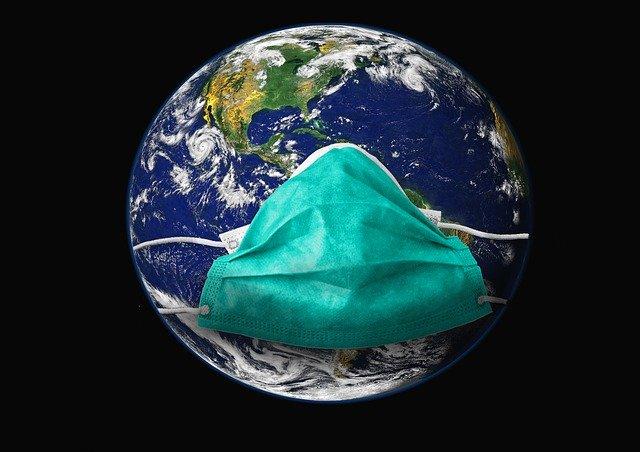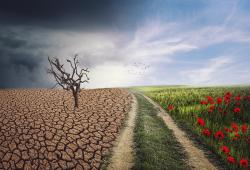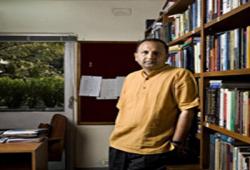
Corona, speculative mischief suggests, must be of divine provenance. She has the intelligence to slumber, to awaken, to migrate, to disappear, to influence, to provoke, to hide, to dodge, to enclose, to mutate. And much more. That is a formidable arsenal of skills for any creature, let alone one invisible to the naked human eye.
Primitive viruses, which are strangers even to virologists, can slumber for countless millennia. Disturbed by industrial mining or melting permafrost from global warming, they can move fast and multiply faster, as long as they find available hosts. And they travel without visas. All they need is an avian, aquatic, animal or human carrier. One of the more predictable consequences of global warming is that countries of the Northern Hemisphere are becoming more vulnerable to tropical diseases like dengue fever. Who knows what primitive pathogens from the era of the dinosaurs will rise up to the surface of our oceans by the ploughing and mining of the world’s sea-bed by 25-tonne tractors for the rare earth metals the growing army of our smartphones need, a project on the global corporate anvil for sometime.
In any case, it helps us to remember that we live, and have always lived in a swirling sea of microbes, which include bacteria and viruses. Listening to experienced epidemiologists like Dr. Ramanan Laxminarayan completely inverts the prevailing, globally popular view of the coronavirus as an ‘enemy’ to be gunned down by the sheer tenacity and power of the collective human will. One would imagine that the human race is under a cosmic invasion from aliens - when our supposed invader has always been living all too close to us.
Disarmingly, Dr. Laxminarayan teaches us the elementary science: “you have to remember the virus has no interest in killing us. It doesn’t do better by killing us. In fact, it does worse…let’s say the virus…killed hundred percent of the people it infected. The virus would never transmit…viruses that are successful are like the common cold viruses that don’t really kill us, and transmit, and they are happy, and we are happy…”
Listening to experienced epidemiologists like Dr. Ramanan Laxminarayan completely inverts the prevailing, globally popular view of the coronavirus as an ‘enemy’ to be gunned down by the sheer tenacity and power of the collective human will.
So, what is so alarming about the coronavirus? “This virus came from animals. This happens every day of the year; there are viruses jumping from animals into humans…We are actually like fish, living in an ocean of bacteria and viruses. They were here before us. They will be here after we are gone. They make life possible for us. There are trillions of them around the place. To say that I don’t want to touch a virus is pretty stupid because they are everywhere…it’s not possible…generally, all infectious diseases, epidemiologists say, are a case of misunderstanding between the virus and us. It really doesn’t want to kill us…it is actually our significant immune response to this ‘invader’ that ends up killing us, because we have never seen anything like this before…” Epidemiologists refer to this as cytokinesis.
What is noteworthy about this particular virus is that, after moving from an animal to a human, it is able to jump from one human to another very swiftly through the respiratory route. “It doesn’t intend to kill” anyone, since that would be a “dead end” for the virus. It would simply like to go on living, like the rest of us. And it can do so by merely finding one or another stable host able to accept and sustain it for the time being. Viruses co-evolve with the immune system of our bodies and can swim to any corner of our bodies once they find entry into the bloodstream.
But all the news is not bad. There is such a thing as what epidemiologists call ‘herd immunity’. “Over time this virus would almost certainly…evolve to be more benign and the mortality rate will come down…we are going to live with this virus forever now, but it’s not going to be an issue for us two or three years from now…it will just be one of the multiple viruses that infect us. I don’t think it is going to change our lives forever…”
Too late
It is clear that the government (as in most parts of the world) has failed in its duty to test a sufficiently large number of symptomatic and asymptomatic people in time, something which could have facilitated more preparedness and better public communication. Public messaging on ‘social distancing’ is still dreadful, seeing how MP politicians are seen on camera embracing each other triumphantly after turning the tables on their electoral rivals, even as police are seen beating poor innocents with lathis for just being on the streets.
Now (reminiscent of the rash 2016 demonetisation) the PM has asked for a national lockdown. Experts are of the view that lockdowns, unguided by testing, are likely to prove counter-productive. Too blanket for precise targeting of virus clusters and inevitably disruptive of the already sinking economy. More people might die of the nature and scale of this response than from the virus. Remember, China was effective because it conducted a focused lockdown in Wuhan and Hubei, so that the rest of the vast country could help. So, we should expect huge chaos, even as specialists believe that we have been in Stage III (community transmission) of the disease for at least two weeks.
Even if only 2% of these cases turn critical (significantly below the global average of 7.5%), it still means that India imminently needs 5.5 million beds in its ICUs. The actual number of such beds at the moment are 70-100,000, which is to say 50-80 times less! Is every single IPL stadium being promptly turned into a quarantine shelter? How quickly can industry adapt to the exponentially rising need for ventilators, hazmat suits, masks, and other medical necessities?
Only severe damage control can be hoped for now. Dr. Laxminarayan’s advice is two-pronged. In order to slow down the spread of the disease (and ‘flatten the curve’, as is being repeatedly hoped), either governments somehow enforce the lockdown for the next three weeks, hugely costly as it will be (especially in India, given poor, densely populated urban neighbourhoods). This would keep the number of infections down, but introduce an old, familiar way to die, as mass starvation in the wake of lost livelihoods takes place in a drowning economy. Are there any plans afoot for provision of free rations to those without work?
Alternatively, we prepare to deal with a “tsunami” of infections over the summer, perhaps conservatively, affecting up to 20% of the total population - which is to say, a staggering 275 million people, most of whom will remain untested and so, below the radar of the government and the media. (It is sobering to keep in view that the expected rate of infections in countries with better healthcare systems, like the UK, is 20-60%). Even if only 2% of these cases turn critical (significantly below the global average of 7.5%), it still means that India imminently needs 5.5 million beds in its ICUs. The actual number of such beds at the moment are 70-100,000, which is to say 50-80 times less! Is every single IPL stadium being promptly turned into a quarantine shelter? How quickly can industry adapt to the exponentially rising need for ventilators, hazmat suits, masks, and other medical necessities?
Assuming for a country like India a significant level of ‘herd immunity’, a desirable condition which almost works like a collective vaccine, and taking a very modest mortality rate of 1% (the world’s being 3-4% so far) means that the country faces the inevitable prospect of 2.75 million deaths before the summer is over. Multiply that number by four if we expect the Indian death rate to be the same as the world’s average. In other words, a scale of loss of human life comparable to the 1918 influenza epidemic. It might be much worse.
As many as 700,000 Indians die every month. What if this number doubles for four months? The consequences will be incalculable along countless dimensions.
We have seen nothing like this in living memory. In this time of climate vagaries, even spring has barely arrived. By the end of the summer, everyone will be living in an utterly changed world.
(Dr. Aseem Shrivastava teaches Ecosophy at Ashoka University and is co-author of “Churning the Earth: The Making of Global India”)







